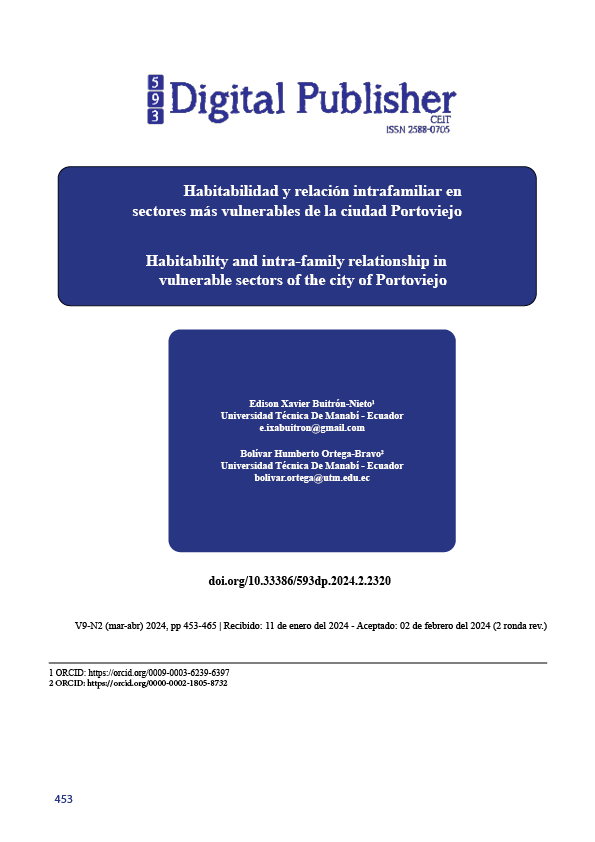Habitability and intra-family relationship in vulnerable sectors of the city of Portoviejo
Main Article Content
Abstract
The research work was based on the analysis of the habitability of the most vulnerable sectors of the city of Portoviejo, Ecuador, as well as on the intra-family relationship that these people live on a daily basis. Considering it necessary to use a qualitative methodology that allows us to know the reality of several families in five vulnerable sectors based on a cadastral analysis of the Municipality of the canton. Interviews were conducted with 10 members of families in a state of vulnerability and 5 officials of the Municipality of the cadastre area, using Quantum GIS software programs (QGIS 2.18.15) and ArcGIS 10. Among the main results, it was established that the city maintains several areas considered vulnerable, both in hills, riverside and low-lying areas, which in winter are greatly affected, and that despite being recorded in the records of solidarity aid, in many cases the relocation has not taken place. Based on the research carried out, it was possible to conclude that it is necessary to have greater socialization and control by the Municipality so that the inhabitants have an option of territorial growth as the number of population in the city increases, which is why the data presented are of great help to reduce risk areas and promote safe housing recreation.
Downloads
Article Details

This work is licensed under a Creative Commons Attribution-NonCommercial-ShareAlike 4.0 International License.
1. Derechos de autor
Las obras que se publican en 593 Digital Publisher CEIT están sujetas a los siguientes términos:
1.1. 593 Digital Publisher CEIT, conserva los derechos patrimoniales (copyright) de las obras publicadas, favorece y permite la reutilización de las mismas bajo la licencia Licencia Creative Commons 4.0 de Reconocimiento-NoComercial-CompartirIgual 4.0, por lo cual se pueden copiar, usar, difundir, transmitir y exponer públicamente, siempre que:
1.1.a. Se cite la autoría y fuente original de su publicación (revista, editorial, URL).
1.1.b. No se usen para fines comerciales u onerosos.
1.1.c. Se mencione la existencia y especificaciones de esta licencia de uso.
References
Acosta, M. (2022). Mejorando vidas en Ecuador. Ciudades Sostenibles. Desarrollo Urbano: https://blogs.iadb.org/ciudades-sostenibles/es/mejorando-vidas-en-ecuador-vivienda-social-inclusiva/
Asamblea Constituyente. (2008). Constitución del Ecuador. Suplemento registro oficial 449 de 20-oct-2008.
Ávalos, L. (2003). Influencia de la habilidad interna de la vivienda en la calidad de vida familiar. Repositorio Institucional. Universidad de México. UNAM. https://repositorio.unam.mx/contenidos/influencia-de-la-habilidad-interna-de-la-vivienda-en-la-calidad-de-vida-familiar-157192?c=1wxJe7&d=false&q=*:*&i=1&v=1&t=search_0&as=0.
Corral, V., Barrón, M., & Cuen, A. (2021). Habitabilidad de la vivienda, estrés y violencia familiar. Revista Psyecology, 357-369. vol 3 (14). https://www.researchgate.net/publication/233688725_Habitabilidad_de_la_vivienda_estres_y_violencia_familiar.
Del Caz, R., & Sainz, J. (2021). Modelo de ciudad y justificación de los emplazamientos seleccionados. Universidad de Valladolid. https://www5.uva.es/grupotierra/aecid/publicaciones/2013/7a.pdf.
Echeverría, M. (2021). Lo cotidiano en la vivienda popular de Quito. EÍDOS., 148-156. Vol 17.
Echeverría, M. (2022). La intervención y la planificación de viviendas en la formalidad o la informalidad. Revista de Arquitectura, 72-83. vol 24(2).
Echeverría, R. (2017). Habitar ciudad: estado de arte en Medellín. Repositorio digital. Universidad Nacional de Colombia. Centro de Estudios Hábitat Popular CEHAP. https://repositorio.unal.edu.co/handle/unal/70028.
García, C., García, J., & García, P. (2023). Riesgo en salud y habitabilidad de viviendas en zonas de alta vulnerabilidad. Revista de Salud Pública, vol 22 (5). https://www.scielosp.org/article/rsap/2020.v22n5/506-512/es/.
Gonzáles, J., & Baldomero, L. (2018). Violencia intrafamiliar: Una mirada desde la adolescencia. Revista Médica del Centro, Vol 12(3). https://revactamedicacentro.sld.cu/index.php/amc/article/view/926.
González, A., & Waldron, J. (2016). Boundaries of Human Factors and Sustaunability in Architecture. In Egronomics in Design, 111-124. https://www.researchgate.net/publication/305769539_Boundaries_of_Human_Factors_and_Sustainability_in_Architecture.
González, D. (2023). Experiencias del programa de viviendas hogar de Cristo en sectores vulnerables de la costa ecuatoriana. Revista Metropolitana de Ciencias Aplicables, 57-66. vol 6(2). https://remca.umet.edu.ec.
Landázuri, A. (2004). Algunos factores físicos y psicológicos relacionados con la habitabilidad interna de la vivienda. Revista de Medio Ambiente y Comportamiento Humano, 89-113. vol 5. https://mach.webs.ull.es/PDFS/Vol5_1y2/VOL_5_1y2_e.pdf.
Mena, R. (2011). Habitabilidad de la vivienda de interés prioritario en reasentamientos poblacionales: una mirada desde la cultura en el proyecto mirador de Calasanz. Repositorio Institucional. Universidad Nacional de Colombia. https://repositorio.unal.edu.co/handle/unal/7353.
Moreno, C. (2002). Relaciones entre vivienda, ambiente y hábitat. Repositorio digital. Universidad Nacional de Colombia. https://repositorio.unal.edu.co/handle/unal/7003.
Olvea, J. (2018). Relación entre condiciones de hacinamietno del hogar y niveles de agresividad en niños y adolescentes de una ONG en la ciudad de Cajamarca. Repositorio Digital. Universidad Privada del Norte. https://repositorio.upn.edu.pe/handle/11537/13957?show=full.
Pi Osoria, A., & Cobian, A. (2009). Componentes de la función afectiva familair: una nueva visión de sus dimensiones e interrelaciones. MEDISAN, Vol 3(6). http://scielo.sld.cu/scielo.php?pid=S1029-30192009000600016&script=sci_abstract.
Portoviejo, M. d. (2018). Plan de Gestión de Riesgo del Cantón Portoviejo. Municipio de Portoviejo. Plan de Integral de Riesgo. Departamento de Catastro .
Quispe, R. (2020). Los derechos humanos en el Sistema Interamericano. Dialnet, 201-203. vol. 14 (2). https://dialnet.unirioja.es/servlet/articulo?codigo=7956679.
Salgado, T. (2020). Medellin Cómo vamos. https://www.medellincomovamos.org/sectores/vivienda-y-servicios-publicos
Secretaria de Gestión de Riesgo. (2021). Minicipio de Portoviejo coordinan acciones para atender viviendas vulnerables. https://www.gestionderiesgos.gob.ec/secretaria-de-riesgos-y-municipio-de-portoviejo-coordinan-acciones-para-atender-viviendas-vulnerables/
UNESCO. (2021). Declaración Universal de la UNESCO sobre la Diversidad Cultural. http://portal.unesco.org/es/ev.php- URL_ID=13179&URL_DO=DO_TOPIC&URL_SECTION=201.html
Valdivia, M., & Valiente, M. (2019). PRincipales factores de riesgo que intervienen en la salubridad de las viviendas de la población de Chilpinilla. Repositorio digital. Universidad Católica de Santa María. https://repositorio.ucsm.edu.pe/bitstream/handle/20.500.12920/8872/60.1436.EN.pdf?sequence=1&isAllowed=y.



